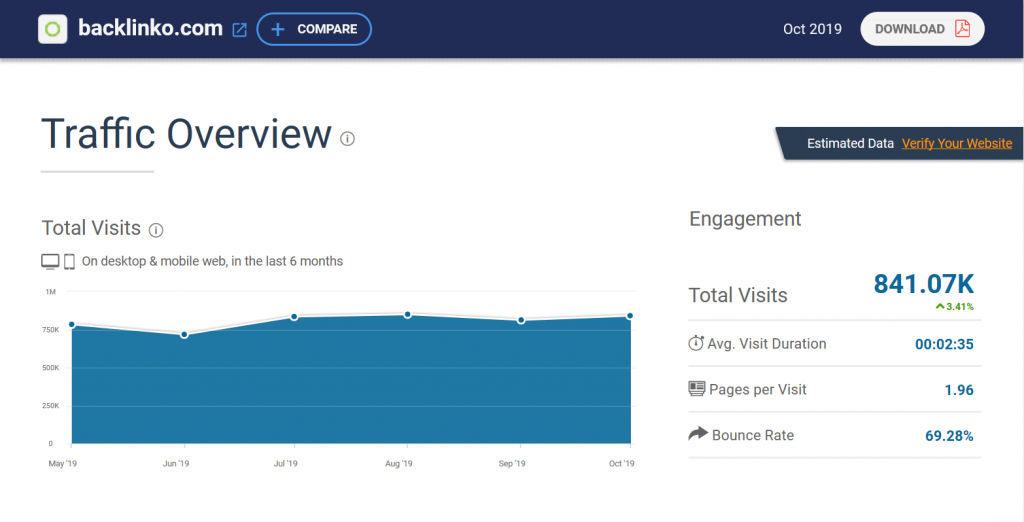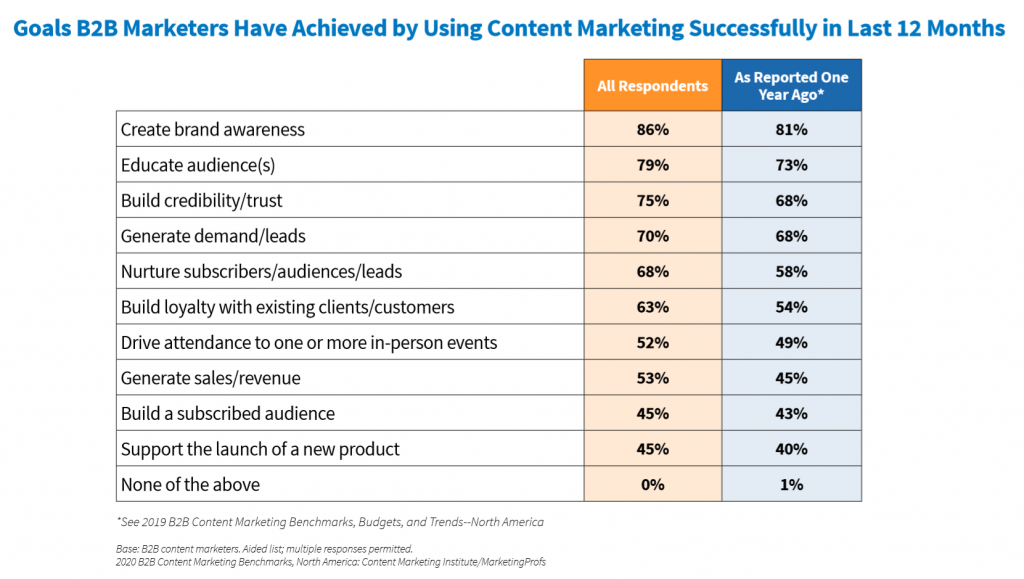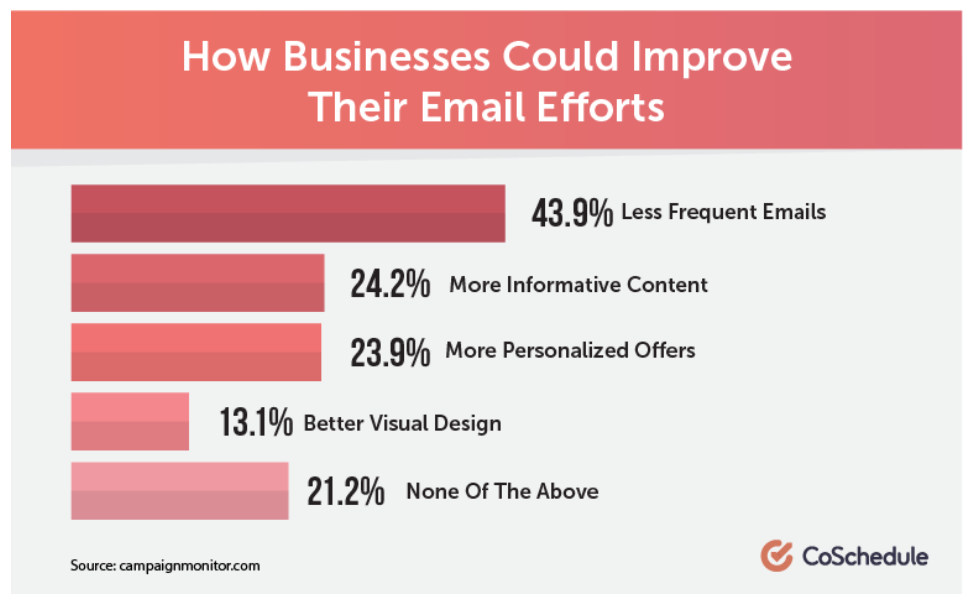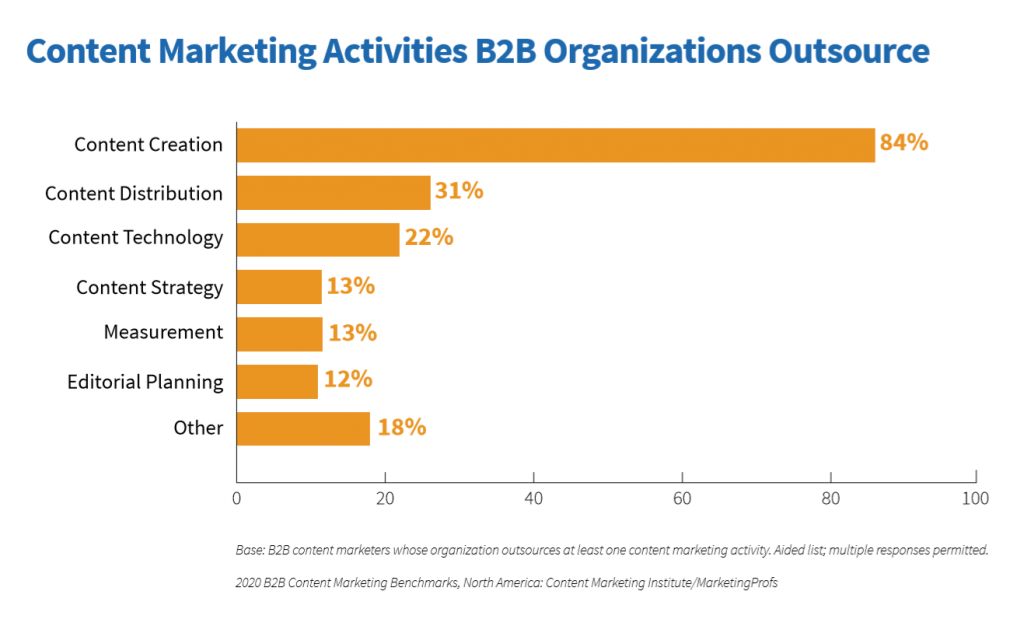How often should your B2B company be blogging?
Every day? Weekly? Monthly?
There’s a famous quote that has been central to the thinking of content marketers for over a decade:
“Think like a publisher, not a marketer.” – David Meerman Scott.
So, how often do digital publishers post new content?
Buzzfeed is one of the most prominent digital publishers. Back in 2016, they published around 700 pieces of content per day.
And they generate a lot of traffic:

But if we take the average of 700 new pieces of content per day, we can estimate that Buzzfeed published over 20,000 new pieces of content in October 2019.
Buzzfeed publishes at a scale far beyond any B2B business, but the message is clear, right?
You should crank out as much content as possible to achieve any success with your B2B content marketing.
However, in the same month of October 2019, Brian Dean attracted an estimated 841.07K visits to Backlinko.com:

How many new pieces of content did Backlinko publish during October?
One per day?
50?
100?
Backlinko only published three new blog posts in the whole of October 2019:

Backlinko isn’t exactly cranking out blog posts at speed, but still generates a considerable amount of traffic, achieves tremendous social media engagement, and ranks high in search engine results.
We can see from Buzzfeed that posting frequency does have an impact, but Backlinko shows us that high-quality and low-frequency can still achieve fantastic results.
How often should a B2B organization be blogging?
Let’s break the factors you should consider when deciding a frequency for your B2B blogging efforts.
Contents
1. What Are Your Goals?
Every B2B content marketing strategy needs set goals. The frequency of your blogging depends on what you are trying to achieve. What are the most common B2B content marketing goals?

Brand Awareness
Building brand awareness is a key goal for B2B content marketers, and it’s an area where the vast majority are seeing success.
If you are focused on increasing the reach of your brand, diversification of content is vital. It’s crucial to identify the ways you can use your content to differentiate your brand and make it memorable.
To build a distinctive voice for your brand, you should focus on sharing helpful information with your audience, but in a way that’s different from what’s already out there.
While a traffic building goal requires a higher posting frequency, brand-building is more focused on finding unique angles for content. To increase brand awareness, create branded infographics and long-form blog posts that deliver lots of value to your audience.
Traffic
If driving traffic is a priority, you want to be posting more frequently. That frequency depends upon your resources. If you’re a small team, it’s good practice to put together a detailed editorial calendar. It’s hard to keep up the quality if you’re trying to brainstorm ideas, write, edit, and promote your content every day.
An organised editorial calendar saves time by ensuring you have a steady stream of ideas to maintain the frequency of your blog content. You want to be posting as often as possible, so break your down topics into clusters and identify ideas for content that will educate your readers. This depends on your audience but can come in the format of listicles, how-to’s, and industry news round-ups.
2. Blogging Frequency vs. Email Frequency
Content marketing and email go hand in hand. Your content is excellent material to share with email subscribers and strengthen your relationship with your prospects, while email marketing is a great way to promote your content and drive traffic to your website.
Should you share every new blog post with your email subscribers?
It can be tempting to share every new blog post with your email list, but it’s best to practice some restraint and not fall into the trap of over-promotion.
CoSchedule conducted a comprehensive analysis of 20 studies to reveal the best email frequency. The results of the compiled studies revealed:

The number one reason people flag a marketing email as spam is receiving too many emails from the company. It’s worth noting that 31.6% of people flag an email as spam because the content is irrelevant – highlighting the need for high-quality content that offers real value to your audience.
Let’s take a look at how people think businesses can improve their email efforts:

Less frequent emails come out on top with 43.9%, but more informative content is next on the list.
What does this mean for your blogging frequency and email promotion of your content?
Sending out a weekly email is what the majority of subscribers want. If your focus is on increasing traffic and producing lots of shorter pieces of content, it’s best to send out a weekly email that promotes the blog posts published in that week.
If you’re focusing on brand awareness, you should maintain the email frequency of once per week, but share a longer and more comprehensive branded piece of content with your subscribers.
3. Consistency Beats Frequency
If you only post once per week, that’s better than posting three times in a single day and publishing nothing for the next month. The consistency of your blogging is more important than the frequency.
Don’t start a posting frequency and fail to deliver. How can you build an audience and increase credibility if you can’t consistently deliver on what you promised?
For example, if you start building your blog with industry news posts, your audience is going to expect you to cover every significant development in your industry – you need to maintain blogging consistency.
Your posting frequency should align with your content marketing goals and what your audience comes to expect from you.
If your focus is increasing website traffic, frequency should be your priority.
If you’re looking to increase brand awareness, longer and more comprehensive content gains the most shares and engagement on social media.
A Moz study of 489,128 articles discovered that long-form content consistently gets more shares:

However, you shouldn’t write longer content just for the sake of it, hoping it will get your more traction on social. Your content should only be long enough to comprehensively cover a topic – this can be a common problem with outsourcing content creation to budget contract writers. If you are paying writers by the word, it can be in the interest of the writer to produce fluffy content.
4. Social Media Distribution
Social media has long been held up as a critical B2C marketing channel, but research shows that it can be a highly effective channel for B2B marketers. According to HubSpot, 75% of B2B buyers use social media to support their purchasing decision.
Where are B2B marketers publishing their content?

LinkedIn is the number one social media platform for distributing B2B content, and it’s an ideal place to get your content in front of a network of decision-making professionals.
With LinkedIn being the go-to for B2B social media content distribution, what’s the best frequency to publish on the platform?
Research shows that LinkedIn activity strongly correlates with routine behavior. Posting at noon usually sees good engagement – you catch professionals during their lunch break. Posting between 5 pm and 6 pm, when people are finishing their workday, is also recommended.
As for the best weekday, content published on Thursday is shown to receive more views than any other weekday:

Research from LinkedIn shows that publishing 20 posts per month enables companies to reach 60% of their audience. Twenty posts averages around one post every working weekday.
Sustaining a publishing frequency of a post per weekday is a serious undertaking, and depends on the next factor – your available resources.
5. Resources
At the end of the day, your available resources will be the deciding factor in your B2B blogging frequency.
It can be disheartening to hear that you should be posting 20 times per month if that frequency is well beyond your available resources.
It’s vital to be realistic and only commit to a schedule where you can maintain quality and consistency.
What are B2B contenting marketing teams doing to maximise their resources and increase their output?
Outsourcing is an option that is popular with half of B2B organisations:

Smaller B2B marketing teams often have to deal with all aspects of their content marketing, with 63% of small B2B businesses keeping all of their content marketing activities in-house.
Large B2B organisations have bigger budgets and outsource more of their content marketing activities.
Which content marketing activities are B2B organisations outsourcing?

We can see that content creation is an activity companies of all sizes are outsourcing, with 84% of B2B organisations using outside contractors.
Retaining editorial planning and content strategy in-house does hold several advantages. Every day, employees at your organisation are talking about your products, discussing industry trends, and answering questions about your business. This information is already available to you and can be vital for informing your content strategy and editorial calendar.
However, the most time-consuming aspect of content marketing is the creation itself. You can research your audience, brainstorm ideas, and put together a monthly editorial schedule in a few days. But consistently realising those ideas and producing quality content is going to require a lot more of your time.
Expending your efforts beyond your limits is going to impact quality, and results are going to suffer. The key is to make use of available information and assess your resources when planning your content marketing strategy.
Which content marketing activities can you outsource to increase efficiency?
How does that impact your budget, and how far can you scale without the quality dropping?
Conclusion
For larger B2B content marketing teams that can utilise more resources, it’s easier to up the frequency of posting to drive more traffic and increase brand awareness.
More established blogs should already have content that drives decent organic traffic, so dedicating more resources to distinguishing the brand through content is an excellent strategy.
For smaller B2B organisations, it’s about finding a balance between brand awareness and driving traffic. If you’re in the early stages of your content marketing strategy, it can pay to reduce the frequency and dedicate your resources to more extensive long-form content that gains more traction in search rankings.
The above information should help inform your B2B content marketing strategy, but it should only be used as a guide.
Trust in the feedback and information that your readers provide you through analytics. Track your results and stick with what’s working to help you achieve your content marketing goals.
- About the Author...







One Response
Hi George, Very useful blog post. It is important to publish blog posts of high quality, whether you are publishing post blogs daily or weekly or on monthly basis. In my email marketing campaign i have noticed that sending every new blog post to your email subscribers leads to subscribers unsubscribing from the email newsletter. It is better to categorize email subscribers in different categories. Send them emails which are customized for that category. This is something that has worked for me.